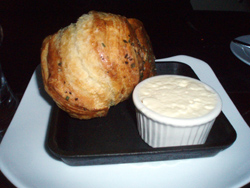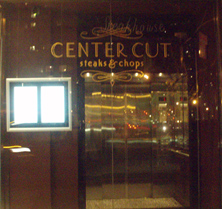Center Cut
 Monday, November 17, 2008 at 09:22PM
Monday, November 17, 2008 at 09:22PM Note: Center Cut closed, replaced by Ed’s Chowder House.
In the increasingly compelling Lincoln Center pre-theater market, the latest entry is Jeffrey Chodorow’s new steakhouse, Center Cut. With 27 restaurants to his name—I think that’s the correct count, unless another has opened or closed in the last 15 minutes—Chodorow doesn’t linger over his projects. He’s had some hits (Asia de Cuba), which are enough to subsidize his many failures.
Center Cut is in the Empire Hotel, directly across the street from Lincoln Center. You’d think it’s the perfect location for a restaurant, but many have come and gone over the 27 years I’ve been watching. Center Cut ought to make it. Steakhouses seldom fail in New York, and this one pushes plenty of populist buttons. The space is lovely, albeit over-built. The menu is straightforward. It’s neither as silly as Chodorow’s now-closed Wild Salmon, nor as cynical as his still-open, but deathwatched, Kobe Club.
This is, of course, a Chodorow production, so you should expect to be mildly annoyed. They wouldn’t transfer our bar tab to our table. Although the restaurant was almost empty, they seated us right next to another party. The hostess supplied menus, “And your server will be able to give you a wine list.” We waited a while, and no server appeared, but fortunately the table next to us had a wine list they no longer needed. I guess there was a good reason, after all, for seating us so close together. The server finally arrived, with Jeffrey Chodorow’s patented Treatise on Upselling firmly in tow.
There are a baker’s dozen signature cocktails, many of them with operatic names (“The Tristan,” “The Isolde”). When you see that they’re $14–17, perhaps you’re not surprised that management is pushing them hard. I think we were asked three times if we’d like to order one. Classic cocktails, such as a Tom Collins or a Side Car, are a few dollars cheaper.
Like most of Chodorow’s places, the menu offers a lot to ponder. For starters, there are eight appetizers ($12–19), five soups ($13–15), and six salads ($9–15), plus a raw bar. For the main course, there are sixteen composed dishes in various categories ($29–41, not counting lobster, for which no price is listed) and six “center cuts,” served à la carte ($35–41 for one, $59–78 for two). For steak, the filet seems to be the best option: you can have it four different ways. There is no porterhouse, though there’s a T-bone for two ($56). There are six available steak sauces and ten sides ($7 each). On top of that, there’s a $39 pre- or post-theater prix fixe, served from 5–7 p.m., or after 10 p.m.

The restaurant’s mantra is, “Where Style & Sustainability Meet.” On the wine list, purveyors are marked with little logos if they’re “Organic,” “Sustainable,” or “Biodynamic.” If you don’t know what those terms mean, don’t worry: there’s a little essay that explains it. The steaks, from Brandt Beef, are alleged to be “natural, humanely-raised, antibiotic and hormone free.” Perhaps I spoke too soon when I said the concept was free of sillyness or cynicism.
Bread service was terrific—a hot Parker House roll (above)—though the butter needed to be softer.


I started with the Slow Roasted Berkshire Bacon ($12; above left), which would have been fine enough on its own, and didn’t need a bed of bitter-tasting “beer roasted onions.” A Caesar Salad ($13; above right) was over-dressed.


The menu warns that its “Flintstone” Brandt Beef Ribs ($32; above left) are “for two or one ‘really hungry person’.” That warning is accurate. The foreshortening of the photo doesn’t do justice to the amount of food you get. Two could easily share this dish, especially if you also order sides. According to the server, the BBQ sauce is a hand-me-down from chef Bradley Day’s family. If so, the Day household was probably a pretty good place to eat. Both the sauce and the meat were done perfectly.
My girlfriend found the prime rib ($35; above right) a bit too salty and not flavorful enough, though I had no objection to the small piece of it that I tasted.


Both side dishes, Potatoes Dophinoise (above left) and Roasted Corn & Manchego Gratin (above center) were excellent. It was good to see compelling options beyond the usual steakhouse classics. Eggplant Fries don’t float my boat, but the Wild Mushroom Strudel is one to try next time.
The wine list is almost all young (2004 or later), and there aren’t many bargains. Except for Beaujolais, nearly all the red bottles are above $65. If three-star restaurants like Café Boulud and Corton can offer a whole page of wines under $60, surely other places can too. I ordered a 2006 Brouilly at $40, mainly because we were going to the opera and I knew we weren’t going to finish it. With most reds by the glass priced at $14 or higher (and I wouldn’t have ordered the ones that weren’t), it seemed like the way to go.
For a nearly-empty restaurant, service ought to have been a bit more attentive. A manager buzzed around the few occupied tables, correcting the staff’s many oversights. The server was a decent enough fellow when you had his attention.
There were hits and misses here, but it looks like one can put together a respectable meal at Center Cut. Most steaks are priced below $40, and there are even some entrées in the high $20s. Those prices aren’t low enough to qualify as bargains, but they are below a number of other steakhouses that have opened in recent years. The bill mounts quickly if you order wine and side dishes, but you can still put together a decent meal here for less than the average Manhattan steakhouse.
Service was uneven, and I’d like to think it will get better with time, except that this is a Jeffrey Chodorow restaurant, and some of the glitches seem to be in China Grill Management’s corporate DNA. I’d certainly like to see more people in the cavernous dining room, lest this restaurant suffer the fate of so many others in the Empire Hotel.
Center Cut (44. W. 63rd St. between Broadway & Columbus Ave., Upper West Side)
Food: *
Service: Acceptable
Ambiance: **
Overall: *





Reader Comments (3)
I compared the wine list of Corton & Center Cut and found the following. Corton does have a page of $65 and under wines, but They only have a total of 21 reds under $65. Center Cut has 17, not much of difference and they shouldn't have been knocked for it. Another thing, they are a new restaurant and being in the business, I understand that it is hard to obtain older vintages unless you want shell out some extra dough, which would place those wines over your $65 mark. You mention them lacking older vintages, (2004), well 20% of their list is under 2004. My question to you is did you look any farther then the 1st page of reds or did you stop a the Pinot Noir/ Gamay Noir page, too bad for you. I asked the sommelier to recommend something under $60 and he brought me, arguably, one of the best Dolcetto I have ever had! I understand the need to bag on El Chode, but you should really get some of your facts straight.
Thanks for the comments. A few points....
Since Center Cut operates at a much lower price point overall, I would expect it to have many more of the inexpensive wines than Corton, not the other way around. In truth, I was being pretty generous in setting the bar at $60.
Yes, I did read the entire wine list. I never said that it doesn’t have some good wines. Although I often spend more, on this particular day I did not want to exceed $50. At a restaurant in Center Cut’s price range, that ought to be easier to do than it is at Corton or Café Boulud.
I do put a high priority on “getting my facts straight,” but I am still not clear which of my facts you disagree with. All I did was point out that the lower end of Center Cut’s wine list is not consistent with the overall price level of the restaurant, which you have not refuted.
A $6 cup of coffee on top of the $39 pre-theater prix fixe?